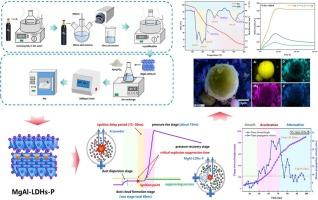Inhibitory effects of phosphorus-containing layered double hydroxides on flame characteristics and overpressure in aluminum dust explosion
IF 4.6
2区 工程技术
Q2 ENGINEERING, CHEMICAL
引用次数: 0
Abstract
To mitigate combustion-explosion hazards associated with aluminum powder in industrial settings, this research investigates the effectiveness of layered double hydroxides (LDHs) in preventing aluminum dust explosions through flame propagation studies and explosion overpressure tests. The article innovatively synthesizes phosphorus-containing layered double hydroxides powder (MgAl-LDHs-P) using the co-precipitation method. It provides a detailed comparison and discussion of the influence of MgAl-LDHs-P powder on the combustion-explosion behavior of aluminum powder under both inerting and explosion inhibition conditions. The experimental results demonstrate that the addition of an appropriate quantity of inhibitors can significantly reduce explosion intensity under inerting conditions. In contrast, the timing of inhibitor release is crucial under inhibition conditions. Furthermore, based on the analysis of explosion products and theoretical calculations, the inhibition mechanism of the material was investigated. This mechanism is primarily attributed to the heat absorption, adhesion, and its capacity to absorb free oxygen radicals. Given that LDHs have a well-established industrial-scale production amplification process, the research presented in this paper can offer new insights into safety protection measures for aluminum powder combustion-explosion.

含磷层状双氢氧化物对铝粉尘爆炸火焰特性和超压的抑制作用
为了减轻工业环境中与铝粉相关的燃烧爆炸危害,本研究通过火焰传播研究和爆炸超压试验,调查了层状双氢氧化物(LDHs)在防止铝粉尘爆炸方面的有效性。采用共沉淀法,创新地合成了含磷层状双氢氧化物粉末(MgAl-LDHs-P)。详细比较和讨论了MgAl-LDHs-P粉末在激发和抑爆条件下对铝粉燃爆性能的影响。实验结果表明,在惰性条件下,加入适量的抑制剂可以显著降低爆炸强度。相反,在抑制条件下,抑制剂释放的时机至关重要。在爆炸产物分析和理论计算的基础上,对材料的缓蚀机理进行了研究。这一机制主要归因于其吸热、粘附和吸收自由基的能力。鉴于铝粉燃爆剂具有完善的工业规模生产放大工艺,本文的研究可以为铝粉燃爆安全防护措施提供新的见解。
本文章由计算机程序翻译,如有差异,请以英文原文为准。
求助全文
约1分钟内获得全文
求助全文
来源期刊

Powder Technology
工程技术-工程:化工
CiteScore
9.90
自引率
15.40%
发文量
1047
审稿时长
46 days
期刊介绍:
Powder Technology is an International Journal on the Science and Technology of Wet and Dry Particulate Systems. Powder Technology publishes papers on all aspects of the formation of particles and their characterisation and on the study of systems containing particulate solids. No limitation is imposed on the size of the particles, which may range from nanometre scale, as in pigments or aerosols, to that of mined or quarried materials. The following list of topics is not intended to be comprehensive, but rather to indicate typical subjects which fall within the scope of the journal's interests:
Formation and synthesis of particles by precipitation and other methods.
Modification of particles by agglomeration, coating, comminution and attrition.
Characterisation of the size, shape, surface area, pore structure and strength of particles and agglomerates (including the origins and effects of inter particle forces).
Packing, failure, flow and permeability of assemblies of particles.
Particle-particle interactions and suspension rheology.
Handling and processing operations such as slurry flow, fluidization, pneumatic conveying.
Interactions between particles and their environment, including delivery of particulate products to the body.
Applications of particle technology in production of pharmaceuticals, chemicals, foods, pigments, structural, and functional materials and in environmental and energy related matters.
For materials-oriented contributions we are looking for articles revealing the effect of particle/powder characteristics (size, morphology and composition, in that order) on material performance or functionality and, ideally, comparison to any industrial standard.
 求助内容:
求助内容: 应助结果提醒方式:
应助结果提醒方式:


